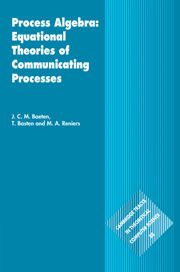Book contents
- Frontmatter
- Contents
- Foreword
- Foreword
- Foreword
- Preface
- 1 Process algebra
- 2 Preliminaries
- 3 Transition systems
- 4 Basic process theory
- 5 Recursion
- 6 Sequential processes
- 7 Parallel and communicating processes
- 8 Abstraction
- 9 Timing
- 10 Data and states
- 11 Features
- 12 Semantics
- Bibliography
- Index of Symbols and Notations
- Index of Authors
- Index of Subjects
10 - Data and states
Published online by Cambridge University Press: 05 July 2014
- Frontmatter
- Contents
- Foreword
- Foreword
- Foreword
- Preface
- 1 Process algebra
- 2 Preliminaries
- 3 Transition systems
- 4 Basic process theory
- 5 Recursion
- 6 Sequential processes
- 7 Parallel and communicating processes
- 8 Abstraction
- 9 Timing
- 10 Data and states
- 11 Features
- 12 Semantics
- Bibliography
- Index of Symbols and Notations
- Index of Authors
- Index of Subjects
Summary
Introduction
In the previous chapters, data types have been handled in an informal way. An alternative composition parameterized by a finite data type D, written as ΣdΣDt with t some process term possibly containing d, was introduced as an abbreviation of a finite expression, and the d occurring in term t was not treated as a (bound) variable. This chapter takes a closer look at data expressions. Such expressions are considered in a more formal way, and the interplay between data and processes is studied. All issues involved can be illustrated by considering just two concrete data types, namely the (finite) data type of the Booleans and the (infinite) data type of the natural numbers. The data type of the natural numbers was also used in the previous chapter to denote time behavior. Considering an uncountable data type as the reals causes additional problems that are avoided in the present text. The use of an uncountable data type in a parameterized alternative composition would, just like the use of an uncountable time domain, provide a means to specify uncountable processes, which is not possible with any of the theories developed in this book.
Notation 10.1.1 (Booleans, propositional logic) Recall from Example 2.3.2 the algebra of the Booleans B = (B, ^, ¬, true). In addition to the constant true and the operators ^ and ¬, the binary operators ∨ (or) and ⊃ (implication), and the constant false are also used in the remainder. The not so common symbol ⊃ is used for implication in order to avoid the use of too many arrows in notations.
- Type
- Chapter
- Information
- Process Algebra: Equational Theories of Communicating Processes , pp. 335 - 374Publisher: Cambridge University PressPrint publication year: 2009



